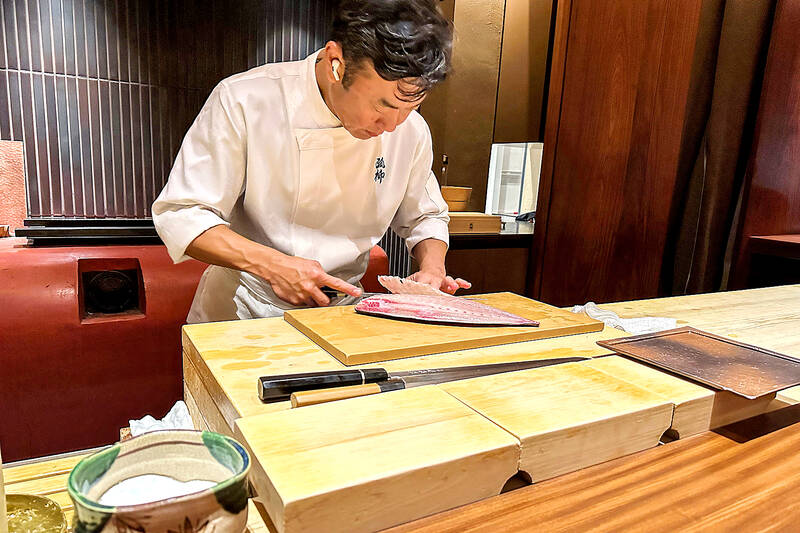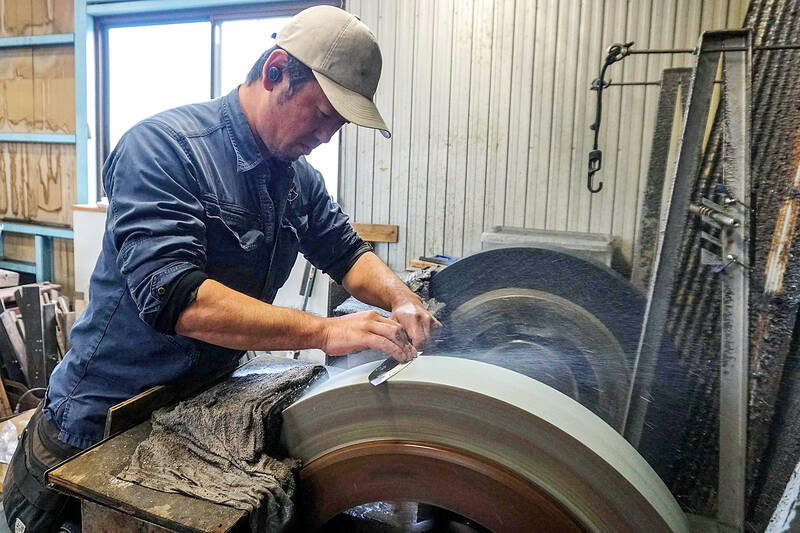Blacksmith Yoshihiro Yauji pulls a piece of glowing metal from the forge in a Japanese village, continuing a tradition dating back centuries to when the region was renowned for crafting swords carried by samurai.
He places the steel under a spring hammer and the sound of the metal being flattened and fortified into a kitchen knife echoes off the mountains surrounding the workshop.
“I believe that blades are the foundational root of Japanese culture,” 40-year-old Yauji said. “If you can condense 700 years, 1,000 years or 1,500 years of technology into a single product, the appeal of the product will be different,” he said, adding that at first, he wanted to make “katana” swords once wielded by samurai.

Photo: AFP
Yauji started at 20 as an apprentice to Hideo Kitaoka, who helped found the collection of cooperative workshops that make up the Takefu Knife Village. After 18 years, Yauji launched his knife line in 2021. But in the 1970s and 80s, the city of Echizen where the knife village is located was in crisis, with artisans unable to compete with cheaper mass-produced tools. Kitaoka and other top blacksmiths banded together to form a cooperative association and, with the help of famed designer Kazuo Kawasaki, began producing designs that turned Echizen knives into works of art.
“At the time of my boss’s generation, the environment was not like it is today; they were struggling just to survive,” Yauji said. “My generation is on the upswing. So I feel it is necessary to once again improve our skills for the brand and its value to continue to exist.”
Around 80 percent of Echizen-made knives are now exported, Yauji said, making their way into professional kitchens around the world and even featuring on hit TV series The Bear.

Photo: AFP
HAND FITS THE KNIFE
The forge at Takefu burns at 900 degrees Celsius, and the handmade Japanese blades drawn from the molten orange core, once hammered, shaped and polished, are sharp enough to split a hair.
“The Japanese knife brings out the best of ingredients. Texture, bitterness, sweetness,” Yauji said. “I think it is a knife specialized to bring out the true flavor of the ingredient itself.”
Knife makers can spend an entire day perfecting a single piece. The metal is heated until malleable and then hammered — a process repeated several times — before being shaped, quenched in oil or water and left to cool. Once the temperature is stable, it is ready to be sharpened. Most blacksmiths hand the knife over to dedicated sharpeners at this stage.
Then, the utensil is ready for the final step of the process: handle making.
“Japanese cutlery is, in my opinion, about the hands learning to fit the tool” instead of the knife being designed for the comfort of the user, Yauji said. “It is a way of trying to establish a deeper connection.”
‘SOUL OF A CHEF’
Using his custom-made yanagiba (willow-leaf blade) sashimi knife, Chef Shintaro Matsuo slices a buttery slab of fatty tuna at acclaimed Osaka restaurant Koryu, considered one of the best fine-dining establishments in a city dubbed Japan’s kitchen.
Matsuo’s dishes combine subtle flavors using ingredients from the surrounding Kansai region, all artfully presented with the help of blades made in Sakai, a small town on the outskirts of Osaka that is considered Japan’s hocho (kitchen knife) heartland.
“The knife is an extension of my hand,” the chef explained, proudly wielding the elongated blade specially made by blacksmith Minamoto Izumimasa.
“Japanese steel allows the flavours of the food to remain intact,” Matsuo added.
Chefs in the country spend years honing their knife skills and patiently learning to master blades that are often more challenging to use and require greater expertise.
“Japanese people have a unique sense of beauty when it comes to cutlery,” said Ryoyo Yamawaki, whose Sakai-based company has been making knives since 1929. “Since ancient times, the Japanese sword is said to have been the soul of a samurai, and the knife the soul of a chef.”

This is the year that the demographic crisis will begin to impact people’s lives. This will create pressures on treatment and hiring of foreigners. Regardless of whatever technological breakthroughs happen, the real value will come from digesting and productively applying existing technologies in new and creative ways. INTRODUCING BASIC SERVICES BREAKDOWNS At some point soon, we will begin to witness a breakdown in basic services. Initially, it will be limited and sporadic, but the frequency and newsworthiness of the incidents will only continue to accelerate dramatically in the coming years. Here in central Taiwan, many basic services are severely understaffed, and

Jan. 5 to Jan. 11 Of the more than 3,000km of sugar railway that once criss-crossed central and southern Taiwan, just 16.1km remain in operation today. By the time Dafydd Fell began photographing the network in earnest in 1994, it was already well past its heyday. The system had been significantly cut back, leaving behind abandoned stations, rusting rolling stock and crumbling facilities. This reduction continued during the five years of his documentation, adding urgency to his task. As passenger services had already ceased by then, Fell had to wait for the sugarcane harvest season each year, which typically ran from

It is a soulful folk song, filled with feeling and history: A love-stricken young man tells God about his hopes and dreams of happiness. Generations of Uighurs, the Turkic ethnic minority in China’s Xinjiang region, have played it at parties and weddings. But today, if they download it, play it or share it online, they risk ending up in prison. Besh pede, a popular Uighur folk ballad, is among dozens of Uighur-language songs that have been deemed “problematic” by Xinjiang authorities, according to a recording of a meeting held by police and other local officials in the historic city of Kashgar in

It’s a good thing that 2025 is over. Yes, I fully expect we will look back on the year with nostalgia, once we have experienced this year and 2027. Traditionally at New Years much discourse is devoted to discussing what happened the previous year. Let’s have a look at what didn’t happen. Many bad things did not happen. The People’s Republic of China (PRC) did not attack Taiwan. We didn’t have a massive, destructive earthquake or drought. We didn’t have a major human pandemic. No widespread unemployment or other destructive social events. Nothing serious was done about Taiwan’s swelling birth rate catastrophe.